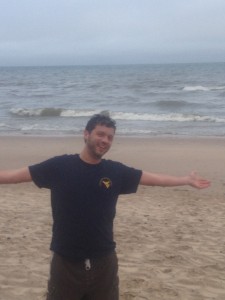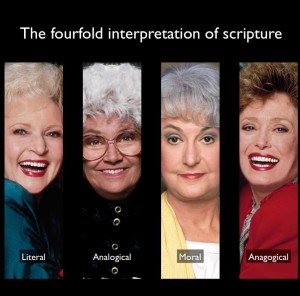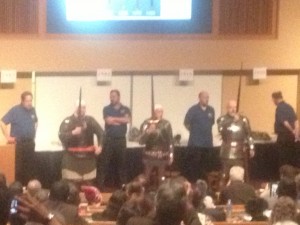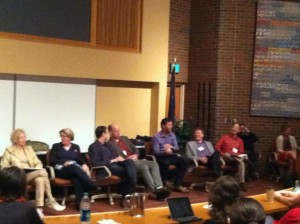Some people register a sense of place through sweet memories of taste and sounds, others through scent and smell, and still others through images in their mind’s eye. To me, the world is made up of stories. Stories full of sound and fury. Great stories are often strangers at home. They defamiliarize banal experiences and everyday utterances while offering something recognizable through a new language and form.
And stories, like people, travel and move around. Stories connect us to other times and places. When Shakespeare’s plays move through different cultures, they reveal unexamined assumptions about human nature and tell surprising stories about globalization. Take, for example, a slice from Hamlet’s inquisitive mind: “To be or not to be, that is the question.” The versatile verb “to be” is as ambiguous in English as it is in many other languages. It has been translated into Russian, German, and Arabic as “to do,” “to die,” and “to have” (but to have or not to have what!?). Translating this speech into Japanese will require substantial rewriting, because Japanese does not have the verb “to be” without semantic contexts. Working with Japanese, a language more complex than English from a sociolinguistic point of view, a translator would have to wrestle with more than 20 first- and second-person pronouns to maintain the ambiguity.
Literary ambiguity is our friend. The ambiguity is a welcome gift for the uninhibited mind, for it has been an ally of oppressed peoples in the Soviet Union, Tibet, South Africa, Poland, and elsewhere. The ambiguity allowed them to express themselves under censorship. When history is held hostage by politics, when human rights are violated, the humanities help restore dignity to what it means to be human. When ambiguity is deliberately eradicated, when things are painted black and white, it is usually during a dark moment of history: the Holocaust, the Cultural Revolution, lynching, the Scottsboro boys incident in the post-Reconstruction South of the Unites States. Hamlet in a foreign language compels us to rethink what we assume to be familiar about our own culture. The humanities in a global context enrich our mind as we pause to ask some fundamental questions. To be whom? To do what?
I was born to Taiwanese parents in a farming village outside Kaohsiung and was raised in Taipei. On sultry summer evenings on the subtropical island of Taiwan, my grandmother would tell me fairy tales under a starry sky, stories about her life story under Japanese colonial rule, and stories of the stones, crickets, and the village. This is how I developed an insatiable appetite for stories—historical, fantastical, political, heroic. As a college student at Tsinghua, I majored in the practically impractical major known as literature. I was fortunate enough to receive a scholarship to study abroad as an exchange student in Germany, where I discovered that the most frequently performed playwright in that country is not Goethe but William Shakespeare. As I would find out later, Shakespeare was an important figure that helped establish a unified German cultural identity and literary tradition in opposition to French classicism. I soon learned that all over the world Shakespeare has been a common cultural touchstone for centuries. A Renaissance poet associated with a theatre called the Globe, Shakespeare had become a global author long before globalization became a catchphrase. There are now Globe theatres in Germany, New Zealand, Japan, the Unites States, Canada, and elsewhere.
My curiosity set me on a path of studying cultural globalization that took me to Strasbourg, France, Oxford, England, and several other countries. When I visited London in 1996, work was under way to reconstruct Shakespeare’s renowned Globe Theatre near its original site on the South Bank that would open in July 1997. I gleefully donated a brick to the project. In the mind of an undergraduate student from a small island nation that has not been recognized by the U.N. and most countries since 1971, that brick was a material connection to the West beyond international politics, to a fascinating historical space, and to the intangible cultural heritage of a “brave new world,” as Miranda would say in
The Tempest. Storytelling is in fact the foundation of Prospero’s magic. The magician frames the world he and his daughter live in with stories that help them heal from the experience of exile and forgive their enemies.
What I was not aware of as I stood at the construction site of the great theatre in London in 1996 was that globalized art means business. The modern Globe is not only a sign of cultural rebirth of London’s once-shady South Bank but is also a perfect example of how the humanities can lead to economic prosperity and transform communities. The number of visitors to the South Bank and the Bankside Cultural Quarter (where the Tate Modern and the Globe are located) jumped from an annual average in the tens of thousands in the 1990s to 13 million in 2011. Another example of this principle is how the humanities informed the core strategies used to market London during the 2012 Olympics. This strategy is being repeated for the 2016 Olympic Games: a reconstructed Globe Theatre is being planned in Brazil to coincide with the games and the 400th anniversary of Shakespeare’s death. Beyond economic implications, we can also learn a great deal about another culture through stories its members tell, and we can always learn about ourselves by comparing how another culture reads a story we know, such as
Hamlet.
Shakespeare’s stories and the stories different cultures tell about Shakespeare eventually led me to California in 1999. American humanities education plants seeds for great changes in people’s lives. As a wide-eyed graduate student at Stanford, I learned from an inspiring, international faculty and cohort of students how to ask probing questions and take history to task and how to find a path through a dark forest of conflicting ideas. To achieve these goals, I studied a number of languages, including Latin, classical Chinese, modern Japanese, German, and French. I learned how to read closely and contextually for both information and untold or silenced stories and how to build sustainable intellectual communities through effective written and oral communication. When it came time to choose a topic for my doctoral dissertation, I initially wanted to stay with a conservative, safe topic in a more established subfield in Renaissance studies. I am thankful that instead I discovered and participated in the creation of global Shakespeare as a new field of study. I am forever indebted to Professor Patricia Parker, whose relentless pursuit of perfection pushed me to take the road less traveled and answer my calling to tell stories. After I earned my doctorate in comparative literature from Stanford, I moved to the east coast and became a scholar of globalization.
As my students at George Washington University’s Department of English and Elliott School of International Affairs tell me, the humanities and especially imaginary literature helps them put human faces on globalization. There are social implications of the fact that today’s college students understand globalization better through the humanities. There are clear benefits to being able to relate to international trade partners and strategic allies on a human level with compassion and not treat them as statistics. Knowledge of cultural globalization can help us avoid cultural imposition and move towards cultural sharing and building common ground.
Story-telling makes us human because it helps us understand the human condition in different contexts.
Recent history has shown that the humanities are greater than the sum of its parts. An eccentric topic for an obsessed researcher may not seem to matter in light of national security or to the general public until we are caught off guard in a crisis when, as in the wake of September 11, we are pressed to learn about who we are, how to come to terms with atrocities, where we as a nation are headed, and why. The humanities are not a luxury; they are the very foundation on which meaningful lives are built. Skills in critical thinking, civil debate, and understanding narratives are vital to American values of freedom, liberty, and social equality, and a democratic society founded upon the government’s accountability and rational citizen participation. This is why public support for the humanities is crucial.
It is a privilege and a unique responsibility to teach Shakespeare and globalization in downtown Washington, D.C., three blocks from the White House. My international and local students alike take pride in studying in the nation’s capital. The American nation was founded upon basic principles of humanistic thought, including the concepts of justice and universal humanity. Capital Hill is a proud host to institutions that foster these ideas, including the Supreme Court, the Folger Shakespeare Library, and the Library of Congress, the oldest federal cultural institution. America clearly values humanities thought: its Library of Congress is the largest library in the world. Today its collection includes over 155 million books and a vast collection of photographs, sheet music, sound recordings, and films on over 838 miles of shelves. The library provides a record of how people lived and expressed themselves in daily life and through the arts.
Shakespeare has helped shape powerful thinkers around the world, including the founding fathers of this nation. Thomas Jefferson kept a commonplace book that featured Shakespearean passages. Abraham Lincoln could recite soliloquies from
Richard III. Language becomes literary when it acquires the power to motivate people and move nations.
In our age of globalization, understanding other peoples’ stories means the difference between being a window shopper and being an informed decision maker in international arenas. Here are two inspiring stories of Shakespeare in South Africa and in China.
A smuggled copy of
The Complete Works of Shakespeare inspired Nelson Mandela while he was in the Robben Island jail. The South African prisoners there signed their names next to passages that were important to them. The passage Mandela chose on December 16, 1977, was from
Julius Caesar, just before the Roman statesman leaves for the senate on the Ides of March in act 2, scene 2:
Cowards die many times before their deaths;
The valiant never taste of death but once.
Of all the wonders that I yet have heard.
It seems to me most strange that men should fear;
Seeing that death, a necessary end,
Will come when it will come.
These lines taught Mandela how to dream and how to rise from the ashes. Through imaginary literature, we, like Jefferson, Lincoln, and Mandela, are able to rehearse multiple scenarios and histories without having endure the costly consequences of going to war or taking one’s own life in a political prison. The humanities can show us the future of the history we are making.
We are defined by our stories. At the same time, stories liberate us from the prison house of a relatively short life span in the infinite universe. Great stories can also give us courage, insight, and vision. In one of my classes, I discuss with my students the impact of the joint project of the National Endowment for the Arts and the Department of Defense to tour the Alabama Shakespeare Festival’s production of Macbeth to thirteen U.S. military bases in 2004. Indeed, what does it mean to read Shakespeare through peace and war?
Wu Ningkun has a moving story to tell. The mainland Chinese intellectual returned from the University of Chicago to join Mao Zedong’s New China in 1951. A decade later, he was sent to reform himself in a labor camp during the Chinese Cultural Revolution because of his alleged association with the capitalist West. Although he was under close surveillance, he still managed to smuggle a copy of Hamlet into the camp to read whenever “the prisoners had to spend the day cooped up in a cell when a blinding blizzard blew from Siberia” in northeastern China. Of this experience, he later wrote in his memoir
A Single Tear: A Family’s Persecution, Love, and Endurance in Communist China:
Hamlet was my favorite Shakespeare play. Read in a Chinese labor camp, however, the tragedy of the Danish prince took on unexpected dimensions. . . . The Ghost thundered with a terrible chorus of a million victims of proletarian dictatorship.
The real question I came to see was neither “to be, or not to be,” nor whether “in the mind to suffer the slings and arrows of outrageous fortune,” but how to be worthy of one’s suffering.
It is interesting to note what Wu elides from the Hamlet quote: “or to take arms against a sea of troubles and by opposing end them.” On the one hand, it could mean that he wishes to counter the unfortunate condition of Cultural Revolution by not taking on a Hamlet-like passivity. On the other hand, it could imply that Wu seeks justice on a more transcendent level and is not seeking revenge upon those who unjustly imprisoned him. Shakespeare helped Wu survive in the labor camp, and reading Wu’s story helps us understand a crucial moment in the making of post-Mao China as the nation emerges from the Cultural Revolution.
Thinkers and leaders such as Lincoln, Mandela, and Wu have drawn inspiration from their reading and built stronger, interconnected communities through the humanities. There will be no national security without an in-depth understanding of our own culture and the cultures of others. Statistics and numbers give us only a partial picture of international affairs. Thoughtful and engaged citizens are the foundation of a democratic, civil society. The humanities enrich the creativity of the business world, enhance the adaptability of workforces, and promote crucial cross-cultural understanding.
Great stories instruct and delight, comfort and inspire. Because you provide public support for the humanities in America and allow us to continue to discover and tell powerful stories to the next generation of Americans, you play a major role in securing the leadership role of the United States. For that, I thank you.












